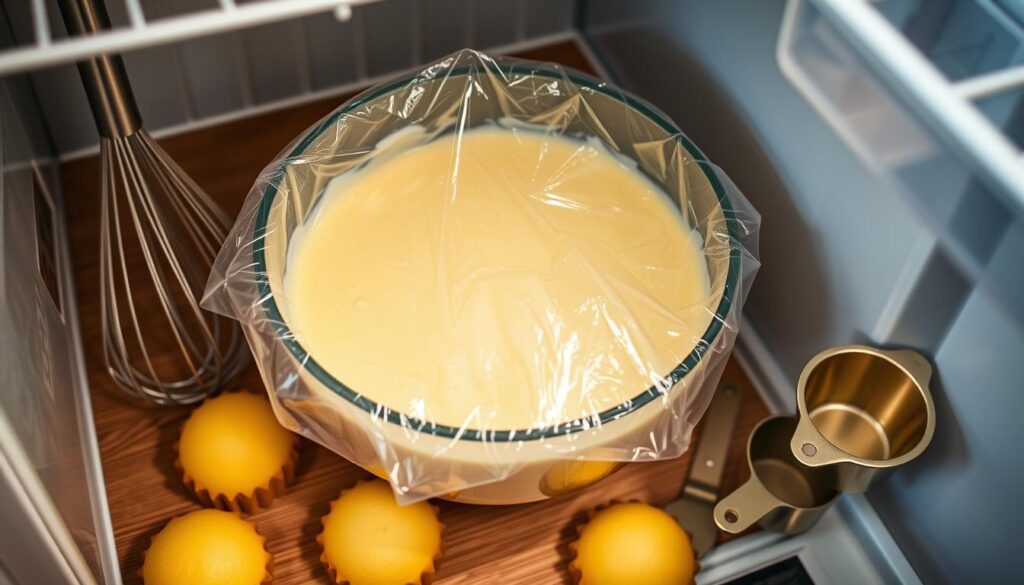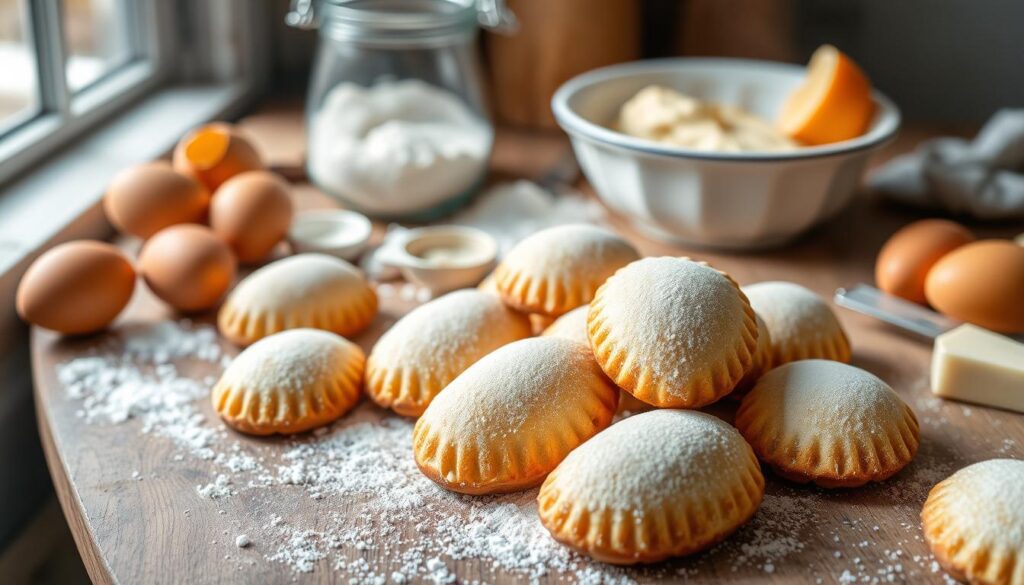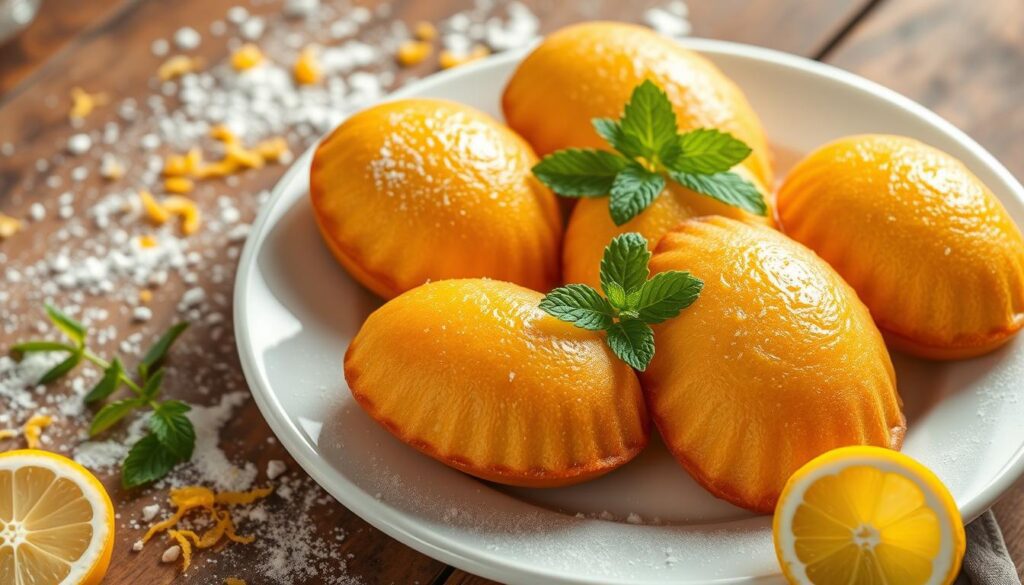Chilling madeleine batter is a key step that greatly affects their texture and taste. The question, “Why do you chill madeleine batter?” is simple yet deep. It lets the ingredients blend, creating the pastry’s signature rise and shell shape.
We’ll look into madeleines, from their history to the science behind chilling. This will help you understand why chilling is so important.
Madeleines are loved for their light texture and unique hump. Learning about chilling and baking tips can improve your skills. You’ll get to make a delicious madeline cookies recipe using cream. So, whether you’re an experienced baker or just starting, join us in mastering the art of making perfect madeleines.

Key Takeaways
- Chilling madeleine batter enhances flavor and texture.
- At least 2 hours of chilling time is recommended.
- Proper preheating is crucial for achieving the madeleine hump.
- Avoid overmixing to maintain a light and airy consistency.
- Following baking time and temperature is essential for optimal results.
Introduction to Madeleines
Madeleines are a beloved type of French pastry known for their light texture and unique shell shape. They come from Commercy, a town in the Lorraine region of France. This introduction to madeleines shows why they are so popular among bakers and dessert lovers.
These classic madeleines are made with simple ingredients like flour, eggs, sugar, and butter. The right mix of these ingredients makes them rich and moist. Eggs add a lot of water, while sugars add flavor and help them turn golden brown after baking.
Flour gives them structure, and T55 French flour is the best choice for real madeleines. Butter and oil add moisture and flavor. Milk makes them richer, and baking powder creates the special “hump” shape. Chilling the batter helps shape them and makes them tender.

Madeleines are also famous in literature, like in Marcel Proust’s “In Search of Lost Time.” They remind us of memories and flavors. Learning about madeleines helps us understand how they are made and why they are loved.
What Are Madeleines?
Madeleines are delightful treats that capture the essence of French baking. This shell-shaped cake has a rich history and a unique profile. They are made from simple yet essential madeleine ingredients like eggs, sugar, flour, and butter. Their fluted design, achieved by using specialized pans, contributes to their appealing appearance and distinct texture.
Traditionally, madeleines boast flavors such as vanilla, lemon, and almond. The batter offers a canvas for creative variations, allowing bakers to incorporate ingredients like cocoa, nuts, or citrus zest. This versatility remains a hallmark of the madeleine, ensuring every bite brings a burst of flavor.
Typically enjoyed warm and paired perfectly with tea or coffee, these charming cakes are a staple in French cuisine and loved worldwide. The process of whipping air into the batter creates a light and airy texture, essential for achieving that classic madeleine quality.
For those looking to master this exquisite shell-shaped cake, understanding its fundamentals is key. This includes the right proportions and methods to handle the batter. Baking with care and precision ensures a delectable outcome.
| Characteristic | Details |
|---|---|
| Yield | 18-20 madeleines |
| Cooking Time | 12 minutes |
| Chilling Time | 30-60 minutes |
| Recommended Pan Cost | Approximately $12 |
| Key Ingredients | 1/2 cup unsalted butter, Eggs, Sugar, Flour |
| Whipping Time for Eggs | 8 minutes |
| Oven Temperature | 350°F (177°C) |

Why Do You Chill Madeleine Batter?
Chilling the madeleine batter is crucial for the final result. It lets the ingredients soak up moisture properly. This makes the batter tender, which is key for the right texture.
If the batter doesn’t hydrate well, the madeleines might turn out tough. This is why chilling is so important.
The Science Behind Chilling
Experts suggest chilling the batter for at least three hours or even overnight. This step helps the ingredients mix well and the batter to stabilize. A cold batter also helps prevent it from spreading too much in the oven.
This is what gives madeleines their unique “hump” shape. Freezing the pans for ten minutes before filling them helps even more. It ensures the batter rises perfectly during baking.
Enhancing Texture and Flavor
Chilling the batter is vital for improving both texture and flavor. As it sits in the fridge, the flavors meld together beautifully. This makes the taste even more enjoyable.
Ingredients like vanilla or lemon zest get a chance to shine. They create a rich and balanced flavor that makes the madeleines truly special. Chilling is a key part of the baking process that makes all the difference.
Benefits of Chilling the Batter
Chilling madeleine batter is key for several reasons. It helps keep the batter moist, which is crucial. This makes the madeleines soft and elastic, giving them a better texture.
Hydration of Ingredients
Moisture in the batter is very important. It makes the flour absorb water, activating gluten. This is vital for the batter to rise well during baking.
As a result, the madeleines keep their shape and stay moist. A moist batter prevents them from drying out. This ensures they come out of the oven fluffy.
Achieving the Signature Hump
The signature hump of madeleines is a must-have in baking. Chilling the batter helps it firm up. This leads to a better rise in the oven.
This thermal shock creates the perfect dome-shaped top. Without chilling, madeleines might not have this desirable shape. They could end up flat and less appealing.
Steps to Properly Chill Your Madeleine Batter
Chilling madeleine batter right is key to a great final product. Knowing how long to chill and the best conditions makes a big difference. Follow these tips for the best taste and texture.
Cooling Time Recommendations
For the best taste, chill the batter for at least three hours. Chilling it overnight is even better, letting the flavors grow. If you’re short on time, a 30-minute chill is okay, but the texture might not be perfect.
Ideal Temperature for Chilling
Keeping the batter at the right temperature is important. Aim for a fridge temperature below 40°F (4°C). This keeps the batter soft and preserves its texture. Don’t chill it in the freezer, as it can make the batter too hard.
Importance of Mixing Techniques
Mixing your madeleine batter right is key to getting that light and airy texture. Knowing the best mixing techniques is crucial for perfection. The method you use can greatly affect your madeleines’ shape and quality.
Mixing Methods that Affect Hump Formation
Gentle mixing is essential for the signature hump. Overmixing can make your madeleines dense instead of fluffy. Here are some methods to try:
- Folding: This keeps air bubbles in, helping your madeleines rise well.
- Whisking eggs and sugar: Whip them together for 5 to 7 minutes until they’re pale and thick.
- Incorporating melted butter: Fold in the cooled melted butter gently for a softer texture.
These methods not only enhance the taste but also help avoid common mixing mistakes.
Common Mistakes to Avoid
Fixing common baking errors can save your madeleines from disappointment. Here are some mistakes to watch out for:
- Overmixing: It fills your cake with too many air bubbles, making it dense.
- Inconsistent chilling: Letting the batter rest for at least 5 hours, or overnight, is key for the right height.
- Improperly greased pans: Not greasing your pans well can cause sticking, making it hard to remove the cakes.
- Skipping preheating: Not preheating the oven can mess with the rise, affecting the cake’s look and feel.
Mastering these mixing techniques and avoiding common mistakes will help you make delicious, fluffy treats. These will surely impress everyone.
Baking Tips for Perfect Madeleines
Getting your madeleines just right takes focus on the baking steps, like preheating the oven. Knowing the right oven temperature is key. It affects the texture and taste of your madeleines.
Preheating the Oven
Start by heating your oven to 425°F (220°C) for madeleines. This high heat helps them rise beautifully. Always check the oven temperature with a thermometer before baking to get it right.
Temperature Adjustments During Baking
After three minutes at 425°F, lower the oven to 400°F (205°C). This two-step process is crucial. It cooks the cakes well without overbrowning. A smooth transition ensures a moist inside and a golden outside.
The Role of Timing in Baking
Timing is everything when baking madeleines. It makes all the difference between a perfect batch and one that’s not. Keep an eye on the oven and adjust as needed. A toothpick test can help you know when they’re done.
| Action | Temperature (°F) | Time |
|---|---|---|
| Initial Preheat | 425°F | 3 minutes |
| Lower Temperature | 400°F | 8 minutes |
| Checking Doneness | – | As needed |
Flavoring Your Madeleine Batter
Madeleines are a great chance to try out different flavors. You can go for classic tastes like vanilla or citrus. Or, you can be bold and add almond or lavender for a unique twist. Making your own flavors can make your treats special and surprise your guests.
Classic vs. Innovative Flavors
There are many flavors to choose from for madeleines. Traditional favorites include:
- Vanilla Extract
- Citrus Zest (Lemon, Orange)
- Almond Extract
But you can also try new things like:
- Lavender Infusions
- Spices like Cardamom and Nutmeg
- Herbal Notes such as Thyme or Basil
Trying different flavors lets you add your own special touch to your baking. It’s a way to make treats that everyone will love.
Using Quality Ingredients
Choosing the right ingredients is key for great madeleines. Use European-style butter for a richer taste. Make sure to pick fresh eggs and organic flour for the best results.
Using real extracts instead of fake ones makes a big difference. It makes your baked goods smell and taste amazing. Paying attention to ingredient quality makes your baking more enjoyable and rewarding.
Storing and Serving Madeleines
To enjoy madeleines fully, storing them right is key. Fresh madeleines are best eaten the same day. If you must store them, use these freshness maintenance tips to keep them tasty. This way, you’ll have a great treat for guests or yourself.
Best Practices for Freshness
When storing madeleines, keeping them soft is the main goal. Store them in an airtight container at room temperature for up to two days. Freezing is also good for longer storage. Wrap each madeleine in plastic wrap and put them in a resealable bag. They can stay frozen for up to a month.
To serve, just thaw them at room temperature. This will make them taste like they were just baked.
How to Serve Madeleines with Beverages
Madeleines are perfect with drinks, like tea and coffee. They add a sweet touch to any afternoon tea. For a new twist, try dusting them with powdered sugar or a light glaze.
Dipping madeleines in warm drinks is also a great idea. It makes the flavor better and adds a fun texture. It’s like going back in time.
| Storage Method | Duration | Notes |
|---|---|---|
| Airtight Container (Room Temperature) | 1-2 days | Best enjoyed fresh, soft texture. |
| Refrigerator | Up to 5 days | Maintain moisture but may lose crispness. |
| Freezer | Up to 1 month | Wrap tightly to avoid freezer burn. |
Conclusion
Chilling the madeleine batter is key to making these French pastries perfect. It makes the hump texture better and helps the ingredients hydrate well. This is crucial for great baking.
By chilling the batter right and following good baking tips, you can get better at making madeleines. This makes your baking more enjoyable and rewarding.
Trying out different flavors, like almonds and lemon zest, makes baking more fun. It adds a special touch to your creations. Also, following the right baking tips, like greasing the pan and using the right temperature, will make your madeleines turn out great every time.
FAQ
Why is chilling the madeleine batter important?
Chilling the batter makes the madeleines better. It makes them tender and prevents them from being tough. It also helps them get their unique hump shape.
How long should I chill madeleine batter?
Chill the batter for at least two hours for the best taste. Chilling it overnight is even better. If you’re short on time, 30 minutes is still good.
What temperature should I chill madeleine batter?
Chill the batter below 40°F (4°C). This keeps it right and prevents it from getting too fermented.
What happens if I don’t chill the batter long enough?
Not chilling enough can make the cakes flat and dense. They won’t have the light, airy texture you want.
Can I use different flavors in my madeleine batter?
Yes, you can try different flavors. Vanilla, lemon, and almond are classic. But you can also use lavender, cocoa, or spices for something new.
What are common mistakes when baking madeleines?
Mistakes include overmixing and not chilling enough. Also, not greasing the molds right and not preheating the oven well.
How do I ensure my madeleines rise properly?
Preheat the oven to 425°F (220°C) before baking. This heat shock helps them rise. Baking in two steps keeps them moist and crispy.
What’s the best way to store madeleines after baking?
Enjoy them fresh for the best taste. Store them in an airtight container at room temperature for a few days. Freeze them for longer.
How can I pair madeleines with drinks?
Madeleines go great with tea or coffee. They’re perfect for afternoon tea. A sprinkle of powdered sugar or a glaze can make them look even better. Dipping them in warm drinks adds a nice contrast.
What are the key ingredients in madeleine recipes?
The key ingredients are eggs, sugar, flour, and butter. Using high-quality butter and fresh eggs makes a big difference in taste and texture.

